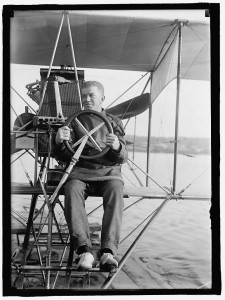The First Naval Aviator
On this day in 1910, Theodore “Spuds” Ellyson, a 25-year-old Navy Lieutenant from Richmond, Virginia, was ordered to report to Glenn Curtiss’s flying school in San Diego as the first Naval officer assigned to aviation.”What was accomplished is now history,” Ellyson wrote later, “namely the develop…

On this day in 1910, Theodore "Spuds" Ellyson, a 25-year-old Navy Lieutenant from Richmond, Virginia, was ordered to report to Glenn Curtiss's flying school in San Diego as the first Naval officer assigned to aviation.
"What was accomplished is now history," Ellyson wrote later, "namely the development of a machine that could rise from, or land on, either the land or the water, a feat that had never before been accompished." A month after he reported to camp, Ellyson was the first passenger to fly in a floatplane, with Curtiss at the controls.
Ellyson had six classmates, three from the Army and three civilians. "All of us who were learning to fly were also interested in the construction of the machines, and when not running "Lizzy" (our practice machine) up and down the field, felt honoured at being allowed to help work on the experimental machine. You see it was not Curtiss, the genius and inventor, whom we knew. It was "G. H.," a comrade and chum, who made us feel that we were all working together, and that our ideas and advice were really of some value."
Even though he was a pioneer of naval aviation, Ellyson's forecasting ability was a little off. In 1912 he predicted:
In my opinion the aeroplane will be used by the Navy solely for scouting purposes, and not as an offensive weapon as seems to be the popular impression. This impression is probably enhanced by the recent newspaper reports of the damage inflicted upon the Turks in Tripoli, by bombs dropped from Italian aeroplanes. Even could an explosive weighing as much as one thousand pounds be carried and suddenly dropped without upsetting the stability of the aeroplane, and were it possible to drop this on a ship from a height of three thousand feet, which is the lowest altitude that would ensure safety from the ship's gun fire, but little damage would be done. The modern battleship is subdivided into many separate water-tight compartments, and the worst that would be done would be to pierce one of these, and destroy those in that one compartment, without seriously crippling the gunfire or manoeuvring qualities of the ship. In only one way do I see that the aeroplane can be used as an offensive weapon, and that is when on blockade duty, with the idea of capturing the port, ships out of range of the land batteries could send out machines with fire bombs and perhaps set fire to the port.